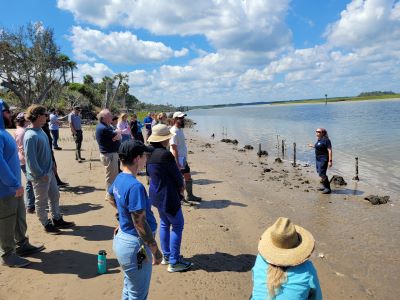

By Vincent Encomio
UF IFAS Extension / FL Sea Grant
Coastal properties are largely protected by hardened structures such as seawalls and bulkheads. The protection afforded by these structures have been at the expense of shoreline habitats, disrupting the 
Living shorelines is a shoreline stabilization practice in which natural elements, such as native plants, oyster reefs, and limestone boulders or rock, are installed rather than traditional hard, grey infrastructure like seawalls or bulkheads. It is a sustainable and resilient method of shoreline protection, while maintaining or enhancing ecological function. The increase of pervious surfaces provided by natural elements also improves water quality by trapping sediments and organic matter, filtering and removing excess nutrients and reducing nonpoint source pollutants. However, there are significant barriers to installing living shorelines in Florida due to a lack of knowledge among private property owners and contractors, a shortage of trained professionals, and permitting regulations that still favor hardened structures over this type of softer, green infrastructure. Perceptions among property owners also present barriers. Familiarity with engineered approaches, uncertainty about the efficacy of living shorelines, and the influence of neighboring armored shorelines can drive decisions away from considering a nature-based approach like living shorelines [1].
To topple these barriers in Florida, partners from state and federal agencies, local governments, non-profits, universities, and private industry developed the Living Shorelines Training for Marine Contractors course. The goal of the course is to train industries involved in marine construction in the 
Florida Sea Grant has been leading this partnership training 343 people over 17 courses throughout the state since 2019. The trainees range from government (38%), the private sector (businesses, contractors, and consultants; 41%), and NGOs, academia, and community members (23%). Outcomes from these workshops show increased knowledge about living shorelines (10-30%) with 58% of attendees reporting they would “definitely” or “likely” add living shorelines to their professional practices [2]. Due to the training, graduates planned and submitted permits for living shorelines for private clients. Several formed strategic partnerships to pursue living shoreline projects, and one partner company hired an engineer specifically to support that effort. The positive impacts from these efforts point to a brighter, more resilient future for Florida’s coastlines aided by a new workforce trained in building sustainable green infrastructure. Florida Sea Grant will continue to connect private industry, property owners, and government agencies to ensure progress towards that future.
[1] Barry, S.C., Reynolds, L.K., Braswell, A.E., Gittman, R.K., Scyphers, S.B., Smyth, A.R. 2024. Perceived effectiveness drives shoreline decision-making for Florida’s waterfront property owners. Ocean and Coastal Management 258:107353.
[2] Martin, S., Barry, S.C., Ubeda, A.J., Encomio, V., Clark, M.W., O’Connor, R., Baily, M.S., Sparks, E. 2024. Reducing barriers to living shorelines through Sea Grant extension programs. Oceanography 37(1):129-133.